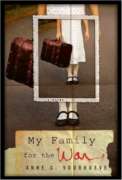
My Family for the War
Written by Anne C. Voorhoeve
Translated from German by Tammi Reichel
Dial, 2012, 412 pp.
ISBN: 978-0803733602
But Professor Shueler shook his head energetically. “You are not responsible for your mother, Ziska. It’s the grownups who have to make the decisions. At one point, your parents made what seems to have been a bad decision, to stay in Germany. But the wonderful thing is that they also made another, very good decision- they were able to save you! Now it’s your job to do everything in your power to make sure the good decision prevails.” (p. 207)
The winner of the 2013 Mildred L. Batchelder Award, My Family for the War, is not really concerned directly with the Holocaust. The action mostly takes place in England and the protagonist (and the reader) never witnesses Nazi atrocities firsthand. Instead, the story takes on the themes of self-discovery and how to live a happy life with the events of the Holocaust as the background.
The plot is sweeping. We follow Franziska Mangold from 1938 until 1947. Ziska is from a comfortable middle class family in Berlin; but because her parents are both “racially” Jewish (her grandparents converted to Christianity), the family is in danger. Unfortunately, like so many of their peers, Ziska’s parents do not realize the extent of the danger until it is too late. The Mangolds have last minute tickets to escape to Shanghai when Mr. Mangold is unexpectedly arrested. Instead of escaping with Ziska, her mother, Margot, decides to stay in Berlin and wait for her husband. Ziska is sent on a Kindertransport to England.
This is where the story really begins. An Orthodox Jewish family, the Shepards, foster Ziska, now Frances, and they become her family for the war. But in reality, because she is with them from the age of 10 until 17, their role becomes that of her real family. This is bittersweet as it forces Frances to go on with her own life while her actual parents struggle for their survival.
There are no easy endings or neatly wrapped lessons in this novel. Ziska’s relatives who survive the Holocaust survive in body only—their spirits are broken. Ziska develops into a practicing Jew who still believes in Jesus. At the end of the novel, she is left to sort out how to live a happy life in spite of Holocaust. It is her job “to do everything in [her] power to make sure the good decision prevails.”
While I admire this novel for its breadth and its realistic endings, I am troubled by its inaccuracies about Judaism. The foster mother, a convert from Ireland, speaks Yiddish in the novel. Conversion lessons include Hebrew, not Yiddish! Ms. Voorhoeve gets much wrong about Jewish customs, from gravestones to sexual taboos. But where the text fails most is in its absence of Yiddishkeit (Jewish sensibility). Ziska’s foster family seems more British than Jewish. While the foster mother speaks excellent Yiddish, there are no Yiddish expressions thrown into their English that are so common with Jews in the U.S and England. The foster grandparents, who are supposedly “super Jews” read like a copy of the Queen and Prince of England. While the kitchen is kosher, its cuisine is British.
As a novel about living with the guilt of being alive, My Family for the War is a good read. But it is not a Jewish book. This would not be an issue, except for the fact the author chose to write about a Jewish family without knowing what it means to be Jewish/Yiddishkeit.
This novel could be a part of a Kindertransport text set grouped with, Into the Arms of Strangers: Stories of the Kindertransport (Mark Jonathan Harris and Deborah Oppenheimer, 2000; film by the same title, 2000), Ten Thousand Children: True Stories Told by Children Who Escaped the Holocaust on the Kindertransport (Anne Fox & Eva Abraham-Podietz, 1999), and Kindertransport (Olga Levy Drucker, 1992). Teachers could also include this text in a thematic set that deals with children who left their biological families during the Holocaust and group it with A Faraway Island (Annika Thor, 2011) and The Upstairs Room (Johanna Reiss, 1990). Another idea would be to use this novel in a text set that examines survivor guilt and read it with Night (Elie Wiesel & Marion Wiesel, 2006) and Man’s Search for Meaning (Viktor E. Frankl, 1984).
The author, Anne C. Voorhoeve, is a German screenwriter and author. My Family for the War is her first novel that has been translated into English. There is scant information on Ms. Voorhoeve in English on the Internet, but according to Wikipedia Deutsch, she has written other novels that take place during the Holocaust.
Melissa B. Wilson, Southeastern Louisiana University, Hammond, LA
WOW Review, Volume VI, Issue 1 by Worlds of Words is licensed under a Creative Commons Attribution-NonCommercial-ShareAlike 4.0 International License. Based on work at https://wowlit.org/on-line-publications/review/vi-1/

Dear Ms. Wilson,
I would be grateful for some details – which are the facts that I neglected to look up, specifically on Wikipedia?
The novel was written in 2005 and I consulted countless books and other media in order to describe two Jewish families in the 1930s and 1940s as credibly as possible. A good deal of the two years of writing this novel (the German original being much longer than the American edition) was spent on research in Berlin and London. Before going into print, the finished novel was read and approved by two scholars with a degree in Judaism. One of them spent most of her life in Israel.
I am very sorry for any mistake which remained in the book, also for maybe not quite catching the spirit of being Jewish in Britain in the 1940s.
With best wishes,
Anne Voorhoeve